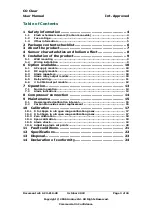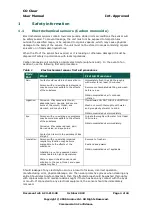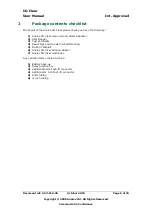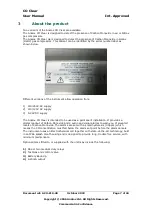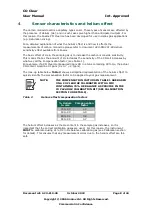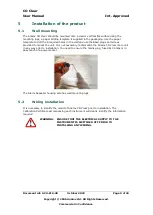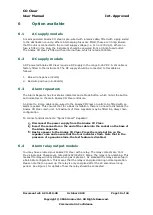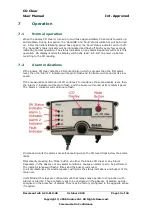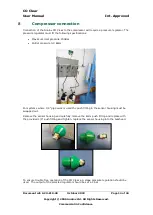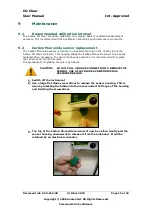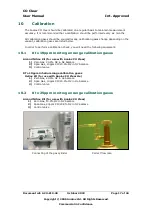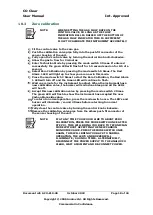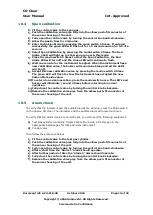
CO Clear
User Manual
Int. Approved
Document ref: ACO-810-28
October 2018
Page 4 of 24
Copyright © 2006 Analox Ltd. All Rights Reserved.
Commercial in Confidence
1
Safety information
1.1
Electrochemical sensors (
Carbon monoxide)
Electrochemical sensors contain toxic compounds. Under normal conditions the sensor will
be safely sealed. To prevent leakage, the unit must not be exposed to temperatures
outside the specified range, or be exposed to organic vapours, which may cause physical
damage to the body of the sensor. The unit must not be stored in areas containing organic
solvents or in flammable liquid stores.
When the life of the sensor has expired, or it is leaking or otherwise damaged it must be
disposed of safely in accordance with local regulations.
Carbon monoxide cell contains an acidic electrolyte (sulphuric acid). In the event of an
accident, use the following first aid procedures.
Table 1
Electrochemical sensor first aid procedures
Body
Part
Effect
First Aid Procedures
Skin
Contact could result in a chemical burn.
Persons with pre-existing skin disorders
may be more susceptible to the effects
of the substance.
Immediately flush the skin thoroughly
with water for at least 15 minutes.
Remove contaminated clothing and wash
before re-use.
Obtain medical advice if continued
irritation.
Ingestion
Corrosive. May cause sore throat,
abdominal pain, nausea, and severe
burns of the mouth, throat, and
stomach, and may be fatal.
If swallowed DO NOT INDUCE VOMITING.
Wash out mouth thoroughly with water
and give plenty of water to drink.
Obtain medical advice immediately
Eye
Persons with pre-existing eye problems
may be more susceptible to the effects
of the substance.
Corrosive. May cause redness, pain,
blurred vision, and eye burns.
Contact can result in the permanent loss
of sight.
Irrigate thoroughly with water for at least
15 minutes.
Obtain medical advice immediately.
Inhalation Persons with pre-existing impaired
respiratory function may be more
susceptible to the effects of the
substance.
Inhalation is not an expected hazard
unless heated to high temperatures.
Mist or vapour inhalation can cause
irritation to the nose, throat, and upper
respiratory tract.
Remove to fresh air.
Rest and keep warm.
Obtain medical advice if applicable.
Should leakage of any electrolyte occur as a result of misuse, incorrect operation,
manufacturing error, physical damage, etc. then wear protective gloves when cleaning any
spills. Should electrolyte contact skin then the affected area should be washed thoroughly
with copious water and medical advice sought if there has been any contact with the eyes
or mouth. If connected to any electrical equipment, the sensor should be immediately
removed.
Summary of Contents for CO Clear
Page 2: ......



